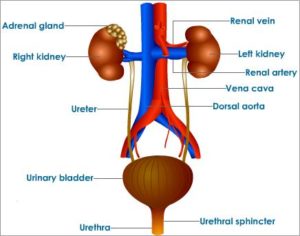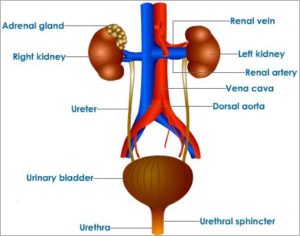Introduction
There is a lotof gases and waste materials produced inside the body of living organisms due to cellular respiration. Such waste products require constant removal in periodic and proper ways to avoid harming the body since they are toxic.
Therefore excretion is the removal of waste products within an organism’s body, a process done by various body parts such as lungs, kidneys, eyes and skin.

For blood to perform its functions of transporting food, air and water to different body parts, it is of importance that it undergoes constant purification. The purification of the blood is one by the excretory system.
The excretory system is composed of:
- A pair of ureters
- Urinary bladder
- Urethra
- A pair of kidneys.
Types of waste products and modes of excretion.
The primary form of waste products is the nitrogenous waste that is formed from the metabolism of proteins, which consist mainly of nitrogen. Nitrogenous wastes take different forms in different animal types that include ammonia, uric acid and urea. Based on these types of nitrogenous wastes,living organisms are divided into the following major categories:
- Ammonotelic– they produce ammonia as the main nitrogenous waste. Examples are fish and frogs.
- Ureotelic- they produce urea as the main nitrogenous waste. Common examples include mammals such as human beings.
- Urecotellic– they produce uric acid as the main nitrogenous waste. Examples are reptiles.
Ammonotelism
This is the process of excreting nitrogenous waste (ammonia). Ammonotelic organisms include birds, reptiles and amphibians. Most of the aquatic animals such as fish and terrestrial invertebrates such as larvae and mammals excrete urea as waste material through ammonotelism.
It is important for these living organisms to excrete ammonia since it can injure cells directly by the alkaline caustic action. This is because ammonia is highly soluble in water whereby it forms ammonium hydroxide,which causes the alkaline caustic action.
In the excretion of ammonia, high amounts of uric acid are required. Part of the uric acid undergoes further oxidation to form allantoin and allantoic acid. In fish such as teleost fish, allantoate or hydration product of allantoin is excreted. In most of the amphibians and fishes, these allantoate is hydrolyzed to form urea and glyoxylate. In marine invertebrates, a further step is undergone where urea is hydrolyzed into ammonia and carbon dioxide. There is the formation of creatine in the liver from amino acids where creatinine is produced from creatine.

Ammonotelism process differs from ureotelism and urecotellism because it requires larger volumes of water for the excretion process.